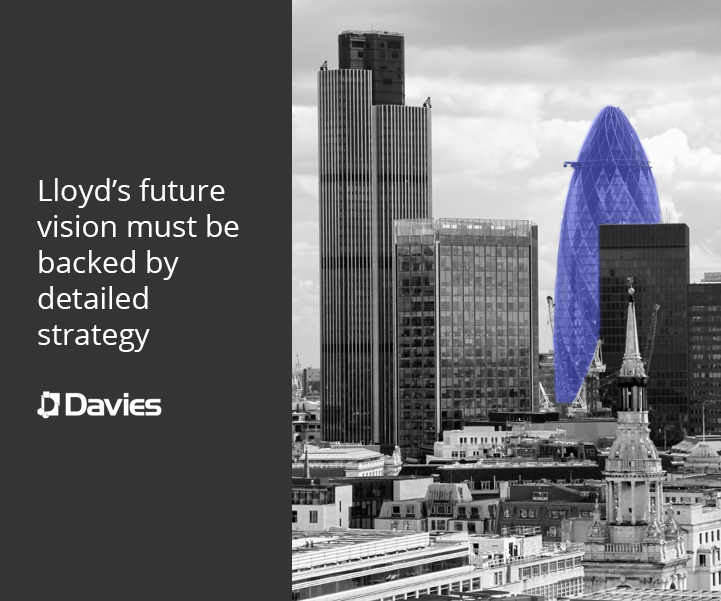Vision is fine but details are sorely needed
21st May 2019

This article was first published by Insurance Day
The future modernisation of the London market has been a topic for over 25 years. In recent weeks, Lloyd’s has circulated its vision for the future in order to consult with all areas of the market in an effort to identify which of the six proposals has traction in the market.
It is no surprise that technology is at the heart of the six potential initiatives given the way in which technology has changed so many parts of our business and personal lives.
There is little doubt that the prospectus that has been produced is a real positive for Lloyd’s. It recognises the fundamental problems it has laboured under for many years. It is a bespoke broker led market and the risks it places are complex and very often unable to be placed elsewhere.
It has built a reputation for innovation and expertise. However, it has also built a reputation for the higher costs of doing business and the time it takes to do business, complexity of the risk aside.
Time and costs are addressed by the document and plans for on-line exchanges, better use of data, syndicates in boxes and fast claims are all headlines for the debate that is underway.
Having attending the launch of the prospectus by Lloyd’s CEO John Neal, the feel was that once the headlines had been read and we started to look at the case studies as to how the six initiatives would work, it becomes a little bit blurred.
The ideas are great in concept but need more detail. The feedback from some in the market around the use of a risk exchange and the ability to standardise some products to allow them to be offered and placed on-line has been mixed.
The other more pressing issue for brokers is that while the idea is to streamline the ability to place and transact business at Lloyd’s, there needs to be a degree of joined up thinking if it is to deliver.
Non Lloyd’s market
Lloyd’s is a significant part of the wider London market but the size and scope of the market outside of One Lime Street needs to be taken into consideration.
While for the broker the use of new technology has to be welcomed if it drives efficiency and speed, unless that technology has been fully thought through then it may well leave the broking sector with more work, not less!
If the technology on which Lloyd’s bases it platforms is not in sync with the technology across the wider London market, brokers may well face the situation where they are having to use different systems to trade with Lloyd’s and then other systems to deal with the rest of the London market. It leaves them faced with the problems of how to build subscription programmes across a number of differing platforms.
The situation we have to avoid is for such systems to be incompatible, leaving the broker taking the view that it is better to go back to walking paper files around the market.
For instance, PPL and DASats are both positives for the market but benefits will be lost if future initiatives do not ensure that they have the ability to interact seamlessly with each other.
The market needs to spell out, in detail, what it believes it can achieve and how it will deliver it. The market will not simply click its fingers and deliver the changes it requires and embed the systems it believes will achieve those aims. Therefore, the next five years are certain to see a period of uncertainty and one where changes will be delivered incrementally.
We all appreciate that if you wait to implement a system until it is 100% functional, it will never happen.
Investment
What it will require from the market is significant investment on projects that will take time to deliver the promised benefits and in many ways, the market’s participants will be told to “speculate to accumulate” in the years to come. I work with both live and legacy companies and they have very different views and appetites when it comes to the investment in technology.
Making it easier to access Lloyd’s is good, the ability to place complex risk electronically is great, attracting more capital into Lloyd’s is good and bringing down the costs of doing business is great but the market has to be able to look at the details of how these will be achieved in order to be provided with the confidence to invest for the future.
The efforts the London market is making to drive technology and process reform will always suffer from the failures of the past. Therefore, those seeking to change the market have to provide the answers to the market’s questions to ensure they instil the confidence that will enable firms to invest in technology and systems needed to enable London to deliver on those aims.
What makes the market so innovative and attractive is the wide range of companies that operate within it. That diversity has to be understood and appreciated. While the global underwriters and brokers have the financial strength to invest in multiple systems, it is a far bigger issue for the smaller brokers and MGA’s.
For the market to achieve its aims, it has to ensure that companies have the confidence that it will be delivered, the confidence that systems will seamlessly communicate across the whole London market and that these systems are designed to allow firms of all sizes the ability to afford to integrate them.
Related Articles
-
- Acquisition
- Article
- Claims Solutions
Acquisition announcement: Davies adds to its specialist motor claims capability with acquisition of GBB Holdings
Davies today announces the acquisition of GBB Holdings incorporating specialist forensic…
-
- Article
- Claims Solutions
- Insurance Solutions
National Customer service week – Day 5
Building brand reputation and trust by delivering on promises Each year…
-
- Article
- Insurance Solutions
Insurance, with no questions asked
This article was first published by Insurance Times. With one-third of…
-
- Article
- Technology
We’re delighted to announce the promotion of Matt Button who steps up to the role of Corporate Development Director
Davies today announces the promotion of Matt Button who steps up…



